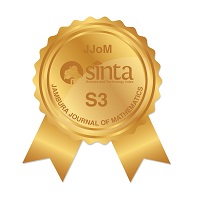Using Real Options and Geometric Brownian Motion Methods to Evaluate Petroleum Projects in Indonesia
Abstract
Keywords
Full Text:
PDFReferences
Global Fire Power, "Crude Oil Production by Country (2024): Ranking the total oil production by country, from highest to lowest" GFP, 2024. [Online]. Available: https://www.globalfirepower.com/oil-production-by-country.php [accessed: Jul. 10, 2024].
CGS International, "15 Proyek Tambah Produksi Sebesar 41 Ribu BOPD pada 2024" 2024.
H. Cheong, B. Kim, and I. U. Vaquero, "A Data Valuation Model to Estimate the Investment Value of Platform Companies: Based on Discounted Cash Flow" J. Risk Financ. Manag., vol. 16, no. 6, p. 293, 2023, doi: 10.3390/jrfm16060293.
A. P. Shivute, "Comparative analysis of discounted cash flow and real options techniques on a gold mining project" Int. J. Min. Miner. Eng., vol. 15, no. 1, pp. 62-78, 2024, doi: 10.1504/IJMME.2024.138731.
B. K. L. Kemala and T. Simatupang, "Real Option Analysis Approach for Pharmaceutical Project Portfolio Optimization Model Considering Multiproject Dependencies" in 2020 7th International Conference on Frontiers of Industrial Engineering, ICFIE 2020, 2020, pp. 40-47, doi: 10.1109/ICFIE50845.2020.9266740.
P. Jalaludin and K. P. Romantica, "Estimasi Nilai Proyek Bioteknologi dengan Metode Learning Options yang Dimodifikasi" Econ. Business, Manag. Account. J., vol. 3, no. 1, pp. 73-81, 2023, doi: 10.61083/ebisma.v3i1.30.
P. Guj and A. Chandra, "Comparing different real option valuation approaches as applied to a copper mine" Resources Policy, vol. 61. pp. 180-189, 2019, doi: 10.1016/j.resourpol.2019.01.020.
P. Jalaludin, A. Rahman, and I. Gumala, "Implementasi Metode Fuzzy BlackScholes Real Options Valuation pada Rencana Investasi Smelter Nikel" KUBIK J. Publ. Ilm. Mat., vol. 8, no. 2, pp. 110-118, 2023, doi: 10.15575/kubik.v8i2.29738.
L. E. Brandão, J. S. Dyer, and W. J. Hahn, "Using Binomial Decision Trees to Solve Real-Option Valuation Problems" Decis. Anal., vol. 2, no. 2, pp. 69-88, 2005, doi: 10.1287/deca.1050.0040.
T. Arnold, T. F. Crack, and A. Schwartz, "Embedding a net present value analysis into a binomial tree with a real option analysis" Manag. Decis. Econ., vol. 43, no. 7, pp. 2924-2934, 2022, doi: 10.1002/mde.3572.
A. Çagri Tolga, C. Kahraman, and M. L. Demircan, "A comparative fuzzy real options valuation model using trinomial lattice and Black-Scholes approaches: A call center application" J. Mult. Log. Soft Comput., vol. 16, no. 1-2, pp. 135-154, 2010, doi: 10.1016/S0165-0114(02)00591-2.
P. Jalaludin, A. Rahman, A. Nuraini, and R. Amigo, "Perhitungan Harga Opsi Eropa dengan Metode Trinomial pada Perusahaan Mitsubishi" J. Lentera Akunt., vol. 9, no. 6, pp. 116-124, 2024, doi: 10.34127/jrakt.v9i1.1179.
F. H. MarÃn-Sánchez, J. A. Pareja-Vasseur, and D. Manzur, "Quadrinomial trees with stochastic volatility to value real options" J. Econ. Financ. Adm. Sci., vol. 26, no. 52, pp. 282-299, 2021, doi: 10.1108/JEFAS-08-2020-0306.
S. A. Ross, M. Rubinstein, and J. C. Cox, "Option pricing: A simplified approach" J. financ. econ., vol. 7, no. 3, pp. 229-263, 1979, doi: 10.1016/0304-405X(79)90015-1.
I. C. Yeh and C. H. Lien, "Evaluating real estate development project with Monte Carlo based binomial options pricing model" Appl. Econ. Lett., vol. 27, no. 4, pp. 307-324, 2020, doi: 10.1080/13504851.2019.1616049.
B. Danylyshyn, S. Bondarenko, M. Malanchuk, K. Kucherenko, V. Pylypiv, and O. Usachenko, "Method of real options in managing investment projects" Int. J. Innov. Technol. Explor. Eng., vol. 8, no. 10, pp. 2696-2699, 2019, doi: 10.35940/ijitee.J9449.0881019.
X. Liu and E. I. Ronn, "Using the binomial model for the valuation of real options in computing optimal subsidies for Chinese renewable energy investments" Energy Econ., vol. 87, no. 7, pp. 1-6, 2020, doi: 10.1016/j.eneco.2020.104692.
Z. S. H. Abad and G. Ruhe, "Using real options to manage Technical Debt in Requirements Engineering" in 2015 IEEE 23rd International Requirements Engineering Conference, RE 2015 - Proceedings, Alberta, 2015, pp. 230-235. doi: 10.1109/RE.2015.7320428.
D. Loncar, I. Milovanovic, B. Rakic, and T. Radjenovic, "Compound real options valuation of renewable energy projects: The case of a wind farm in Serbia" Renew. Sustain. Energy Rev., vol. 75, no. October 2016, pp. 354-367, 2017, doi: 10.1016/j.rser.2016.11.001.
F. A. S. Postali and P. Picchetti, "Geometric Brownian Motion and structural breaks in oil prices : A quantitative analysis" Energy Econ., vol. 28, no. 20, pp. 506-522, 2006, doi: 10.1016/j.eneco.2006.02.011.
S. Benninga, Financial Modeling, 4th ed. Massachusetts: The MIT Press, 2015. doi: 10.1002/9781119204992.ch6.
K. A. Sidarto, M. Syamsuddin, and N. Sumarti, Matematika Keuangan, 1st ed. Bandung: ITB Press, 2019.
K. Kim, H. Park, and H. Kim, "Real options analysis for renewable energy investment decisions in developing countries" Renew. Sustain. Energy Rev., vol. 75, no. 34, pp. 918-926, 2017, doi: 10.1016/j.rser.2016.11.073.
DOI: https://doi.org/10.37905/jjom.v6i2.26718
Copyright (c) 2024 Paiz Jalaludin, Alrafiful Rahman, Ani Nuraini

This work is licensed under a Creative Commons Attribution-NonCommercial 4.0 International License.
Jambura Journal of Mathematics has been indexed by
Jambura Journal of Mathematics (e-ISSN: 2656-1344) by Department of Mathematics Universitas Negeri Gorontalo is licensed under a Creative Commons Attribution-NonCommercial 4.0 International License. Powered by Public Knowledge Project OJS.
Editorial Office
Department of Mathematics, Faculty of Mathematics and Natural Science, Universitas Negeri Gorontalo
Jl. Prof. Dr. Ing. B. J. Habibie, Moutong, Tilongkabila, Kabupaten Bone Bolango, Gorontalo, Indonesia
Email: [email protected].




















